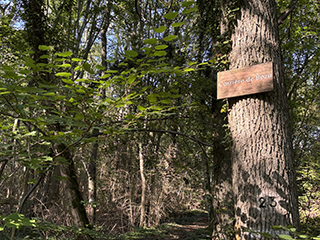
Sentiers du Patrimoine ®
Chérence
Carrière de Bézu

Revenir par le même chemin jusqu’au carrefour. Prendre à droite pour regagner le chemin principal qui revient au village. Poursuivre sur le Chemin de la Mare à Guitot, suivre la rue des Cabarets et prendre le chemin de la Corniche jusqu’à la Petite Croix.
Prochain point : Lat.49.087048, Long. 1.674706"
This former open-air quarry is one of many that once dotted the commune. It provided access to Lutetian limestone, a stone formed around 40 million years ago, which forms the bedrock of the French Vexin plateau. While Lutetian limestone is abundant in the region, the stone from Chérence has specific characteristics. It is of excellent quality, highly durable due to its silica content, and was therefore used in the construction of numerous monuments, particularly in Paris: the platform of the Arc de Triomphe, the Church of La Madeleine, the equestrian statues on the Pont d’Iéna, as well as the church of La Roche-Guyon and the bridge in Mantes.
Limestone from Chérence was likely quarried from the Middle Ages. Its exploitation became intense in the 18th century. The stone was transported by cart to river ports such as Vétheuil, from where it could be shipped by boat or sent via rail from stations in Mantes, Vernon, or Bonnières. Quarrying was a major economic activity in the village throughout the 18th and 19th centuries, with several families living from this industry, working as quarrymen, including the Boucher and Fournier families. Extraction declined around the turn of the 20th century and eventually ceased. Several quarries, however, remain the property of the commune and can still provide stone for occasional construction and restoration projects within the village.

